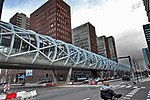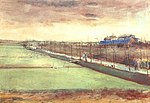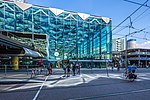Den Haag Laan van NOI railway station
Railway stations in The HagueRailway stations on the Oude LijnRailway stations opened in 1907RandstadRail stations in The Hague

Den Haag Laan van NOI railway station is a railway station in the Netherlands, on the border between The Hague and the town of Voorburg. It is served by the Nederlandse Spoorwegen (Dutch railway) and by the RandstadRail light-rail network. The station is named after the road on which it is located, Laan van Nieuw Oost-Indië, which literally translates as New East Indies Avenue, but probably refers to a former inn called Nieuw Oosteinde (New East End).
Excerpt from the Wikipedia article Den Haag Laan van NOI railway station (License: CC BY-SA 3.0, Authors, Images).Den Haag Laan van NOI railway station
Van Heurnstraat, Leidschendam-Voorburg
Geographical coordinates (GPS) Address Nearby Places Show on map
Geographical coordinates (GPS)
| Latitude | Longitude |
|---|---|
| N 52.078888888889 ° | E 4.3430555555556 ° |
Address
Spoor 4
Van Heurnstraat
2274 NK Leidschendam-Voorburg
South Holland, Netherlands
Open on Google Maps










